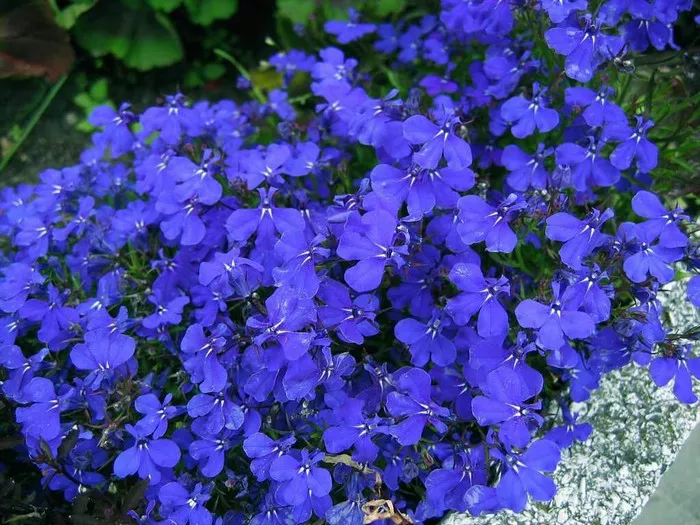Lobelia, a genus of flowering plants comprising over 400 species, captivates with its diverse array of colors, shapes, and sizes. From vibrant cascades of blue to fiery hues of red, these delicate blooms adorn gardens, landscapes, and floral arrangements worldwide. Whether you’re an avid gardener, a nature enthusiast, or simply curious about botanical wonders, delving into the world of Lobelia flowers offers a captivating journey of discovery.
Lobelia, named after the Flemish botanist Matthias de Lobel, belongs to the family Campanulaceae and is native to various regions across the globe, including North and South America, Africa, and parts of Asia. These versatile plants range from annuals to perennials, with some species thriving in moist, shady environments, while others prefer sunny, well-drained soils.
One of the most distinctive features of Lobelia flowers is their tubular shape, which often attracts pollinators such as bees, butterflies, and hummingbirds. The flowers typically bloom in clusters along slender stems, creating a striking visual display in gardens and natural landscapes. While blue is the most common color, Lobelia flowers also come in shades of purple, pink, white, and red, adding diversity and charm to any floral setting.
Anatomy of Lobelia Flowers
To appreciate the beauty of Lobelia flowers fully, it’s essential to understand their anatomy. Each flower consists of several key parts, each contributing to its overall allure and functionality:
1. Petals: Lobelia flowers typically have five petals arranged in a tubular shape, often with a two-lipped appearance. The petals may be fused at the base, forming a distinct throat where nectar accumulates, attracting pollinators.
2. Sepals: Surrounding the base of the petals are sepals, which serve as protective structures for the developing flower bud. Sepals may be green, blending seamlessly with the stem, or brightly colored, adding contrast to the flower’s appearance.
3. Stamens and Pistil: Within the tubular throat of the flower, stamens and pistils play crucial roles in the reproductive process. Stamens produce pollen, while the pistil contains the ovary, where seeds develop after successful pollination.
4. Stem and Leaves: Lobelia flowers arise from slender stems adorned with lanceolate or ovate leaves, adding a verdant backdrop to the colorful blooms. The leaves may vary in size and texture depending on the species, ranging from smooth and glossy to serrated or hairy.
Understanding the anatomy of Lobelia flowers enhances one’s appreciation for their intricate beauty and ecological significance within their natural habitats.
Varieties of Lobelia Flowers
With hundreds of species and cultivars to choose from, Lobelia offers a vast array of options for gardeners and floral enthusiasts. Some of the most popular varieties include:
1. Lobelia erinus: Also known as edging lobelia, this species is prized for its compact growth habit and profusion of small, delicate flowers. It is often used as a border plant in gardens and hanging baskets, where its trailing stems create a cascading effect.
2. Lobelia cardinalis: Native to North America, Lobelia cardinalis, or cardinal flower, is renowned for its striking scarlet-red blooms and tall, upright growth habit. It thrives in moist, woodland environments and is a favorite among hummingbirds and gardeners alike.
3. Lobelia siphilitica: Commonly known as great blue lobelia, this species boasts stunning spikes of blue flowers that light up shady corners of the garden. It prefers consistently moist soil and is an excellent choice for rain gardens and pond edges.
4. Lobelia laxiflora: With its clusters of vibrant orange flowers and slender, arching stems, Lobelia laxiflora adds a splash of color to sunny borders and rock gardens. This drought-tolerant species attracts butterflies and bees, making it a valuable addition to pollinator-friendly landscapes.
These are just a few examples of the diverse range of Lobelia species available to gardeners and floral enthusiasts, each with its unique characteristics and growing requirements.
Caring for Lobelia Flowers
While Lobelia flowers are relatively low-maintenance, providing optimal growing conditions is essential for their health and vitality. Here are some tips for caring for these beautiful blooms:
1. Light and Temperature: Most Lobelia species prefer partial to full sun, although some varieties thrive in partial shade. Ensure adequate air circulation to prevent fungal diseases, especially in humid climates.
2. Watering: Lobelia flowers have moderate water requirements and prefer consistently moist, well-drained soil. Avoid overwatering, as this can lead to root rot and other moisture-related issues.
3. Fertilization: Apply a balanced fertilizer during the growing season to promote healthy growth and abundant flowering. Follow the manufacturer’s recommendations for application rates and frequency.
4. Pruning and Deadheading: Regular deadheading of spent flowers encourages continuous blooming throughout the growing season. Prune back leggy stems to maintain a tidy appearance and encourage branching.
5. Pest and Disease Control: Monitor plants for signs of pests such as aphids, slugs, and snails, and take appropriate measures to control infestations. Practice good garden hygiene to prevent the spread of fungal diseases.
By providing proper care and attention, gardeners can enjoy a profusion of colorful blooms from their Lobelia plants year after year.
Conclusion
Lobelia flowers, with their diverse colors, intricate anatomy, and ecological importance, are a source of fascination and delight for gardeners and nature enthusiasts worldwide. Whether adorning garden borders, attracting pollinators, or brightening up floral arrangements, these versatile blooms never fail to captivate with their beauty and charm. So, the next time you encounter a cluster of Lobelia flowers in bloom, take a moment to marvel at their beauty and reflect on the intricate wonders of the natural world that surround us.


